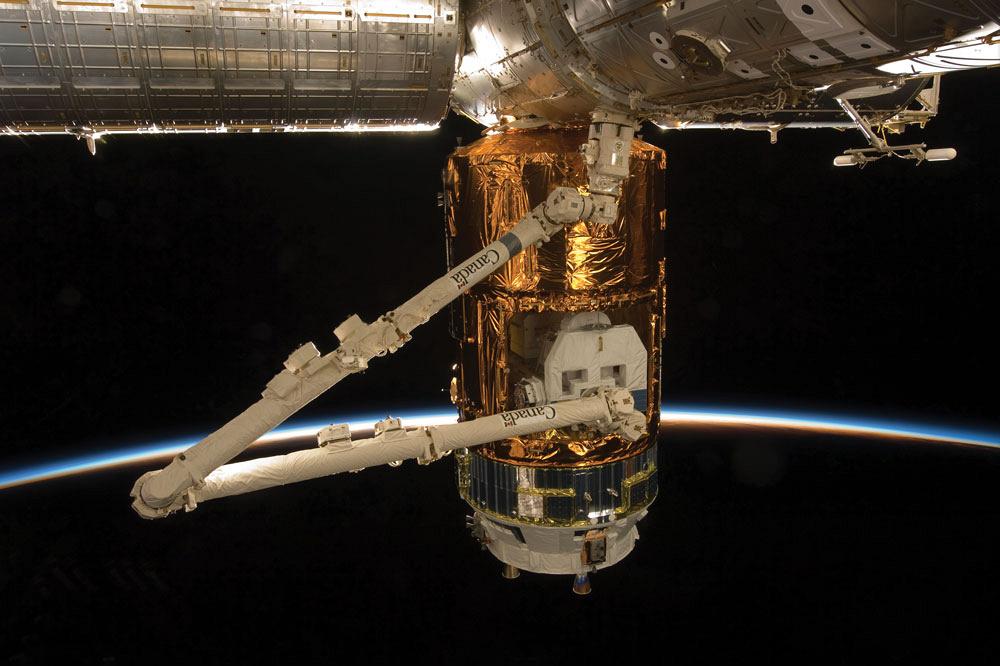Editor
- FMA
- The Fabricator
- FABTECH
- Canadian Metalworking
Industry Update: Aerospace news for 2022
Sector’s leadership position under threat as COVID-19 affects production, jobs
- By Joe Thompson
- March 7, 2022
- Article
- Made In Canada

The Japanese Kounotori2 H-II Transfer Vehicle (HTV2), docked to the Earth-facing port of the Harmony node and in the grapple of the Candarm2. The thin line of Earth’s atmosphere and the blackness of space provide the backdrop for the scene. Stocktrek Images
Aerospace manufacturing is important to Canada.
This pan-Canadian enterprise includes civil, defence, and passenger aircraft production; highly technical work that ends up in outer space, such as the famous Canadarm and Canadarm2 robotic arms; and many other areas like simulation and MRO work. Billion-dollar multinationals—some of which are homegrown success stories--and the supply chains these companies support, can be found in nearly every region and province in the country.
Government and industry work together to strengthen the sector, because if they don’t, they risk losing our nation’s leadership position. It’s a rare case in which there is little to no animosity between industry and what can be seen as the government overlords.
Late last year the Aerospace Industries Association of Canada (AIAC) and the federal government’s Department of Innovation, Science and Economic Development (ISED) released a joint report about the state of Canada’s aerospace industry.
“This report is an important account of the productive partnership between our government and the aerospace industry,” said François-Philippe Champagne, minister of innovation, science and industry. “As we had recognized in Budget 2021, aerospace was one of the sectors hardest hit by the pandemic. We will continue to support our aerospace champions every step of the way to build on Canada’s strengths, continue our global leadership, and develop new competitive advantages in the green economy of the future.”
COVID Causes Chaos
The 2020 report quantifies the impacts of the COVID-19 pandemic both on aerospace jobs and the sector’s economic activity and points to a long recovery. According to the report, the overall aerospace industry’s contribution to the Canadian economy decreased by $6.2 billion in GDP between 2019 and 2020. The sector also lost 27,900 jobs, with the largest portion of these occurring in Ontario.
Far from a Canadian problem, the global aerospace industry had similar declines too.
On a positive note, revenue losses in Canada were somewhat mitigated when compared to the global average because of the diversity of Canada’s aerospace sector, which includes a global leadership position in business aircraft production. Large aircraft production had a much bigger drop in demand and output through 2020. It should be noted that Canada ranked No. 2 in the world in the manufacture of business jets in 2020, which was consistent with its 2019 ranking even with the uncertainty of COVID-19 hanging over everyone’s heads.
Even despite the steep decline in jobs and GDP contribution, it’s safe to say that Canada remains an innovation and export leader in this manufacturing segment. Aerospace manufacturing R&D intensity and share of STEM employment are three times the national manufacturing average, which indicates a willingness of the industry’s top managers to still re-invest in tomorrow, even though today may look a bit bleak.
Between 2019 and 2020, the aerospace manufacturing industry’s investment in R&D was relatively stable ($934 million in R&D investment in 2020 compared with $1.4 billion in 2018, and five times higher R&D intensity than the manufacturing average in 2018).
The sector also is much more export-intensive (35 per cent more) than the Canadian manufacturing average.
In 2020 the Canadian aerospace industry contributed over $22 billion to the country’s GDP and employed close to 207,000 workers. Comparing this with the 2019 numbers shows a significant loss in both areas. In 2019 the sector contributed $28.5 billion to GDP and employed 235,000 Canadians.
“We thank the government and the department for their continued collaboration and for this year’s report, which is perhaps the most important to date,” said Mike Mueller, president/CEO of AIAC. “These are very sobering numbers. Job losses on this scale are felt in families and communities across the country. How we plan our aerospace recovery will set the stage and determine our competitiveness for the next 30 years.”
Where Canada Excels
Canadian aerospace maintains its position as a global leader in several segments. These include:
- No. 1 in civil flight simulators
- No. 3 in civil engines
- No. 4 in civil aircraft
The Canadian aerospace manufacturing industry exports more than 75 per cent of its products each year. In 2020 this meant exports were shipped to 186 countries across six continents.
“We have so much to build on,” added Mueller. “Our companies, large and small, are major exporters and integral to global supply chains. For example, Canada’s expertise and leadership in smaller business aircraft helped to buoy against even steeper declines seen globally; the global average was brought down by the plummet in demand and production of large aircraft. Business aircraft is a strength and competitive advantage for Canada, providing a solid foundation for recovery and jobs.”
Editor Joe Thompson can be reached at jthompson@canadianmetalworking.com.
Aerospace Industries Association of Canada, www.aiac.ca
About the Author

Joe Thompson
416-1154 Warden Avenue
Toronto, M1R 0A1 Canada
905-315-8226
Joe Thompson has been covering the Canadian manufacturing sector for more than two decades. He is responsible for the day-to-day editorial direction of the magazine, providing a uniquely Canadian look at the world of metal manufacturing.
An award-winning writer and graduate of the Sheridan College journalism program, he has published articles worldwide in a variety of industries, including manufacturing, pharmaceutical, medical, infrastructure, and entertainment.
subscribe now


Keep up to date with the latest news, events, and technology for all things metal from our pair of monthly magazines written specifically for Canadian manufacturers!
Start Your Free Subscription- Industry Events
Automate 2024
- May 6 - 9, 2024
- Chicago, IL
ANCA Open House
- May 7 - 8, 2024
- Wixom, MI
17th annual Joint Open House
- May 8 - 9, 2024
- Oakville and Mississauga, ON Canada
MME Saskatoon
- May 28, 2024
- Saskatoon, SK Canada
CME's Health & Safety Symposium for Manufacturers
- May 29, 2024
- Mississauga, ON Canada




















